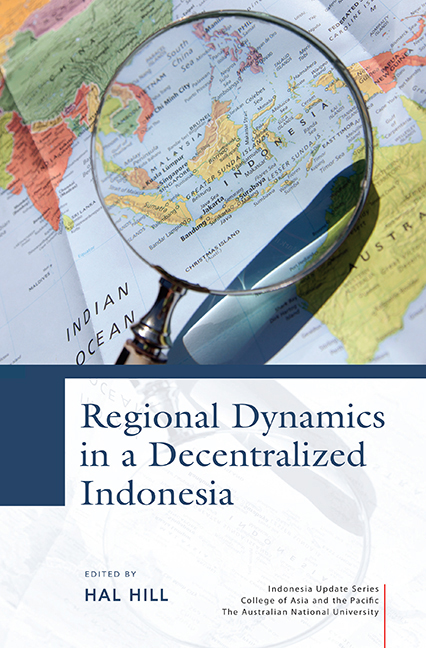Book contents
- Frontmatter
- Dedication
- Contents
- Tables
- Figures
- Contributors
- Acknowledgments
- Glossary
- Map of Indonesia
- 1 An introduction to the issues
- PART 1 HISTORICAL, ECONOMIC, POLITICAL AND SOCIAL PATTERNS
- PART 2 DECENTRALIZATION AND GOVERNANCE
- PART 3 LOCAL-LEVEL PERSPECTIVES
- PART 4 MIGRATION, CITIES AND CONNECTIVITY
- 13 Migration patterns: people on the move
- 14 Regional labour markets in 2002–12: limited convergence but integration nonetheless
- 15 The dynamics of Jabodetabek development: the challenge of urban governance
- 16 Challenges of implementing logistics reform in Indonesia
- PART 5 CHALLENGES FOR INDONESIA'S PERIPHERY
- Author index
- Subject index
- INDONESIA UPDATE SERIES
13 - Migration patterns: people on the move
from PART 4 - MIGRATION, CITIES AND CONNECTIVITY
Published online by Cambridge University Press: 21 October 2015
- Frontmatter
- Dedication
- Contents
- Tables
- Figures
- Contributors
- Acknowledgments
- Glossary
- Map of Indonesia
- 1 An introduction to the issues
- PART 1 HISTORICAL, ECONOMIC, POLITICAL AND SOCIAL PATTERNS
- PART 2 DECENTRALIZATION AND GOVERNANCE
- PART 3 LOCAL-LEVEL PERSPECTIVES
- PART 4 MIGRATION, CITIES AND CONNECTIVITY
- 13 Migration patterns: people on the move
- 14 Regional labour markets in 2002–12: limited convergence but integration nonetheless
- 15 The dynamics of Jabodetabek development: the challenge of urban governance
- 16 Challenges of implementing logistics reform in Indonesia
- PART 5 CHALLENGES FOR INDONESIA'S PERIPHERY
- Author index
- Subject index
- INDONESIA UPDATE SERIES
Summary
INTRODUCTION
In the last few decades, Indonesia has witnessed many changes in its demographic and socio-economic characteristics. Today, Indonesians have smaller families, longer life expectancy and more education. The average number of children per woman, as measured by the total fertility rate, declined from 4.6 in 1980 to 2.6 in 2010 (BPS 2012). Over the same period, life expectancy increased from 57.6 to 69.4 years. The implementation of compulsory education started with six years of schooling in 1984, increasing to nine years in 1994 and 12 years in 2012. This has significantly increased school enrolment rates; the net enrolment rate for senior secondary school, for example, increased from 17 per cent in 1975 to 51 per cent in 2012 (BPS 2013). In response to such significant changes, and the concomitant developments in local and global economic conditions, population mobility and migration patterns have also changed considerably.
At the same time, there have been significant improvements in transport, especially road and air transport, and in communications technology, which have also facilitated population mobility. The growing Indonesian diaspora, estimated to number 3–6 million (Muhidin and Utomo 2013), is further evidence of Indonesians’ willingness to migrate. Mobility is a complex process involving the interaction of a wide range of factors, both personal and to do with the regions of destination and origin. Using the concept of a ‘mobility continuum’, Pooley, Turnbull and Adams (2005: 3) have observed that population mobility may include simple mobility (travel for work, shopping or leisure), circular mobility (involving regular longer travel) and longer-distance residential migration. The latter concept of mobility is the focus of this chapter.
According to the 2010 population census, Indonesia is home to 238 million people, about 27 million (12 per cent) of whom live outside their provinces of birth (BPS 2011). The proportion of such migrants varies widely across regions, however, from less than 3 per cent in the provinces of East Java, West Nusa Tenggara and Central Java, to as much as 42 per cent in Jakarta and 48 per cent in Riau Islands.
- Type
- Chapter
- Information
- Regional Dynamics in a Decentralized Indonesia , pp. 317 - 341Publisher: ISEAS–Yusof Ishak InstitutePrint publication year: 2014

